Raiders vs. Cruisers
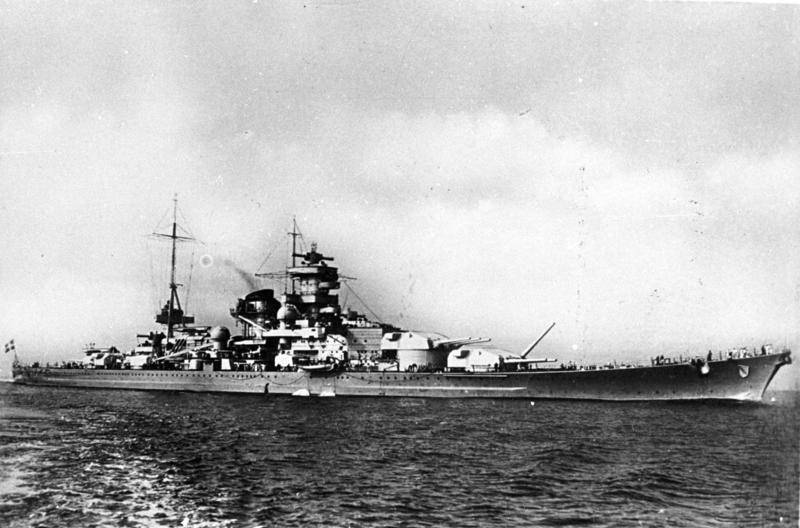
In the future, the growth of resistance of the Anglo-Americans to the sea led to the fact that the Germans stopped betting on surface ships in such operations and finally switched to conducting submarine warfare (omitting the "Condors" as a strike tool we’ll omit, in this case it doesn’t matter) . And, as is widely known again, Germany lost the submarine war in the 1943 year.
We, however, are interested in the stage with surface ships. It is of interest because, firstly, the Germans missed some opportunities, and secondly, the fact that they missed these opportunities contains a very interesting lesson that goes far beyond the Second World War.
But first, we note one important nuance. Very often, in relation to German surface ships that performed combat missions in communications, the word “raider”, derived from the word “raid”, is used in Russian literature. This is one of the problems of the modern Russian language - we do not call things by their proper names, which then prevents us from properly understanding the essence of events. Especially in a rigid form, this problem exists during translations, sometimes completely distorting the meaning of concepts. We will define the concepts to begin with - the German warships performed not just raids, they fought a cruising war on the communications of the British. These were cruising forces, and so it is necessary to understand the importance attached to them by the highest German military command. A raid is a type of action that is applicable not only in cruising war. Roughly speaking, a military expedition to hostile waters for the purpose of destroying convoys can be considered a raid, but not every surface ship raid is a cruising operation against shipping. In understanding this fact lies the lost opportunities of the Germans.
Cruising war and raids
According to the “Sea Dictionary” K.I. Samoilov, published by the State Naval Publishing House of the USSR NKVMF in 1941, was defined as “cruising war” as “operations against enemy maritime trade and against neutral commercial ships that deliver warfare to the enemy”. Was this what the Germans wanted to do and did? Yes.
Turn to the classics. In the epoch-making work of Alfred Thayer Mahan, "The Influence of Maritime Force on history"(Here they are, the difficulties of translation, because Mahan wrote not about sea power, but about power, power - power applied in time, continuous efforts, sea power, but this is completely different) about the war on communications there are such wonderful words:
и
Not seizures of individual ships and caravans, even in large numbers, undermine the financial strength of the country, but the overwhelming superiority of the enemy at sea, which expels its flag from its waters or allows the latter to appear only as a fugitive, and which, making the enemy the master of the sea, allows him to lock the water trade routes leading to the shores and from the shores of a hostile country. Such superiority can be achieved only through the medium of large fleets ...
Mahan gives a ton of historical examples of how these dependencies worked - and they worked. And, unfortunately for the Germans, they worked for them too - all of Germany’s attempts to wage a war on communications, not reinforcing it with surface actions fleetfailed. Germany lost both world wars, including due to the inability to withdraw England from the war. And if in the First World War Germany had a large fleet, which she simply simply did not really use, then in the Second everything was much worse - a surface fleet that could make Royal Navi at least wait for the German attack, abandoning active offensive operations, simply did not have. The Germans found a way out, without getting involved in battles with the British fleet, to try to destroy British trade by attacking transport ships and convoys from them. The exit turned out to be false.
But does this mean that German efforts in the war on the sea against Britain were doomed completely?
Let us turn to the concept of a different, than cruising war or cruising. Alas, with reference to the war at sea, foreign definitions will have to be used, translating them relatively accurately.
A raid is a type of military action of tactical or operational importance, when the attacking forces have a special task, and should not remain in the area of the combat mission for a longer time than is assigned to accomplish it, but on the contrary, must leave it so quickly that the enemy is late counterstrike, and move away under the protection of the main forces.
It would seem that this definition is a great reminder of what has traditionally been called the word “raid” in our fleet. That's just the raid is performed by ships striking the land. The raid is a special case of the raid, the “special task” of which is that the attacking forces, ships, must strike the coastal target, whatever it may be, from fuel depots to the enemy ships in the base. Nowadays, the relevance of the raid actions is seriously reduced by the appearance of cruise missiles - now they just don’t have to go to the target on the coast, it is attacked from a great distance. But forty years ago, the raids were quite relevant.
Let us ask ourselves the question: if a raid is a special case of a raid, then there are other options for raider actions. Can a raid be considered a raid whose purpose is to destroy a guarded convoy and go back? As mentioned above - it is possible, and this will also be a special case of the raid, as well as a raid.
What is left behind the brackets? For brackets left raid operations aimed at the destruction of enemy warships, temporarily in the minority against raiding forces.
The Germans, faced with the total domination of the British, and then the Anglo-Americans at sea, chose an asymmetrical tactic - a cruising war, the impossibility of winning in which, without the support of a powerful fleet, Mahhen perfectly justified. At the same time, the possibility of sending raiders for the purposeful “shooting” of warships by the British was not fully used by the Germans. But such operations, firstly, would immediately begin to change the balance in the forces at sea in favor of Germany, if carried out correctly, of course, and secondly, and most importantly, the Germans had quite successful examples of such actions as really successful and potentially successful, but during which they again refused to achieve the result.
Consider three episodes of the German war at sea, and taking into account not only the actual results achieved, but also those from which Kriegsmarine refused to achieve.
But first, let us answer the question: does the fleet, which is fighting in a significant minority, have the prerequisites for achieving success against an adversary that is numerically superior and dominant at sea?
Speed vs. Mass
The boxer knows the truism perfectly: a knockout is not a super hard blow, it is a missed strike. What is necessary for the enemy to miss it? It is necessary to be more technical and faster, and the force of the blow should simply be sufficient, and not prohibitively large. It is also needed, of course, but the main thing is speed. You should be faster. And hardier, so as not to lose speed too soon and have time to "catch" the moment.
This simple rule is never more applicable to military action. Getting ahead of the enemy in deployment, maneuver and withdrawal is the key to the success of raid actions, and even small forces against large ones can achieve this. Why is that? Because the adversary who dominates the sea is burdened with an obligation that he cannot refuse to fulfill — he must be literally everywhere.
Recall the Second World. The British fleet conducts operations "around" Norway. Fights with Italians in the Mediterranean. Conducts surveillance and patrol of the German coast, where it can. Holds strength in the metropolis. Guards convoys in the Atlantic. Empowers to chase raiders. And this dispersion of forces has obvious consequences - it’s not easy to assemble ships into a fist for the destruction of enemy forces, naturally, when an attacker ensures the surprise of his actions (which is a priori necessary for any combat operation).
Consider this problem on the example of the operation of the Royal Navy against the "pocket battleship" "Admiral Graf Spee". Formally, the British abandoned three formations of a total of one aircraft carrier, one battle cruiser, four heavy cruisers, and light cruisers hastily escaping to catch the “battleship”. In practice, these forces were so scattered across the South Atlantic that only one very weak combination of the heavy cruiser Exeter and two light cruisers Ajax and Achilles could detect the Admiral Spee. The rest were late, another British heavy cruiser arrived only when the Exeter had already lost its combat effectiveness from the fire of the Spee guns.
At first glance, the campaign "Spee", which ended with its self-drowning, is a complete failure. But we must clearly understand that this is not the failure of the ship and not the idea of such a campaign, this is the failure of the battleship commander Hans Langsdorf. He won the battle stitch, he disabled the only enemy ship that could pose a serious threat to him, he had fire superiority over the remaining British ships. Yes, the Spee was damaged, its crew suffered losses. Yes, the enemy had superiority in speed. But on the other hand, the “Spee” had a tremendous superiority in range - only a week had passed since the receipt of the fuel, and the fuel on board was enough to break. Langsdorf could well, shooting, to leave at least from light cruisers.
Then, of course, it could turn out differently, but in those years it was quite a non-trivial task to drive a single ship into the ocean. It is not even easy right now. Even, rather, difficult. And what if Langsdorf made the decision to break? In the best case for the Britons, the result would be a long and exhausting chase across the ocean, where the British would need to introduce more and more ships into the operation, then to force Spée somewhere to fight, which is not a fact without loss. In the worst case, the British cruisers, who had spent fuel, would have been forced to throw off the course, the reinforcements would have been late or “overshot”, and the Spee would have gone home.
The fact that Langsdorf first drove his ship into a dead end, then, refusing to attempt to break through with the battle, he himself flooded it, and then shot himself, was not due to anything but his personal will. The British in the course of the war more than once sacrificed themselves in hopeless battles and died by whole crews for one or two hits on the target, and having the opportunity to escape. Nobody prevented the Germans from behaving in the same way.
There was no good option to take and swat the arrogant loner among the British, despite the monstrous superiority in forces over Kriegsmarine. Why? Because they had to be everywhere, and the ships are not an infinite number, and the enemy holding the initiative can take advantage of this.
This is the main prerequisite for the success of the raid, even in conditions where its goal is not attack convoys and other "cruising" actions, unable to ensure victory in the war, even if successfully completed, but search and destruction of weak combat groups and single enemy warships. To level the balance.
The Germans did not set themselves such plans and goals, they either did not understand their importance, or did not believe in feasibility.
The irony of fate is that they did it and did it well. But - by chance. Consider them in more detail.
Episode 1. Operation "Yuno"
4 June 1940, the German battleships Scharnhorst and Gneisenau, and the heavy cruiser Admiral Hipper sailed from Wilhelmshaven to the open sea. By June 8, the German combat group already consisted of the Scharnhorst, Gneisenau, the heavy cruiser Admiral Hipper, the destroyers Z20 Karl Halster, Z10 Hans Lodi, Z15 Erich Steinbrink, and Z7XXXXXXXXXXXXXXXXXXXXXXXXXXXXXXXXXXXXXXXXXXXX The compound was commanded by one of the most experienced German commanders, Admiral Wilhelm Marshal.
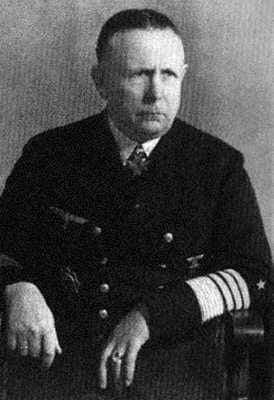
The combat mission of the compound had a foray into Harstad, Norway. According to the German command, such an operation would ease the position of the German troops in Narvik. Thus began the German operation "Yuno" ("Juno"). However, on the same day, June 8, when the battle group moved towards its goal, the Germans learned that the allies were being evacuated from Norway. The attack has lost its meaning. Marshal, however, decided to find and destroy a convoy with evacuees.
He did not find him. The group managed to destroy only two transport ships - the military transport Orama and the tanker Oil Pioneer. Along the way, the minesweeper Juneper was sunk. But in the second half of the day, the combat group called “caught” a completely outstanding prize — the aircraft carrier Glories, escorted by a pair of destroyers. The results are known. The battleships sank everyone, and the only damage that the British managed to inflict is a torpedo hit from the destroyer Akast that cost the life and crew of the destroyer (remember the English ability to fight to the end, which Langsdorf lacked) and fifty sailors from the Scharnhorst.
Shots from Operation Yuno
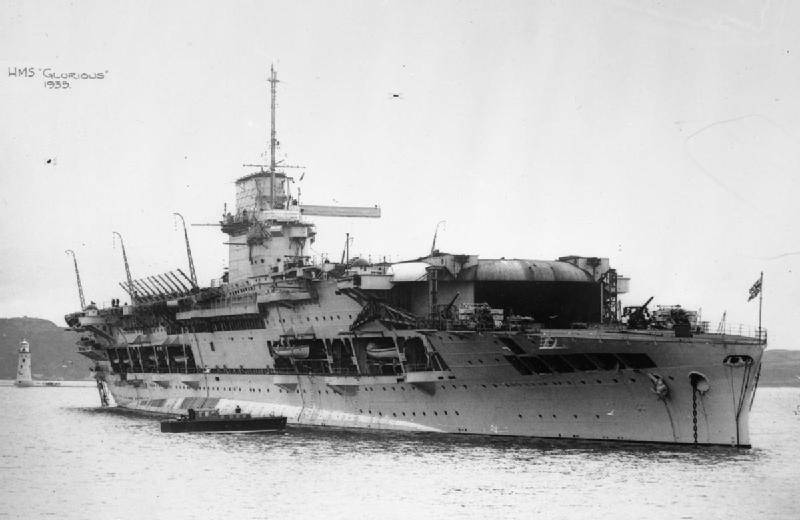
Now let's estimate how much the British had in the area of operation. The aircraft carriers Glories and the Ark Royal, the heavy cruiser Devonshire, the light cruiser Coventry, and the light cruiser Southampton were in the immediate vicinity of the battlefield. At a distance of less than a forced daily transition were the battleships "Velient", "Rodney", the battle cruisers "Rhipals" and "Rinaun", the heavy cruiser "Sussex".
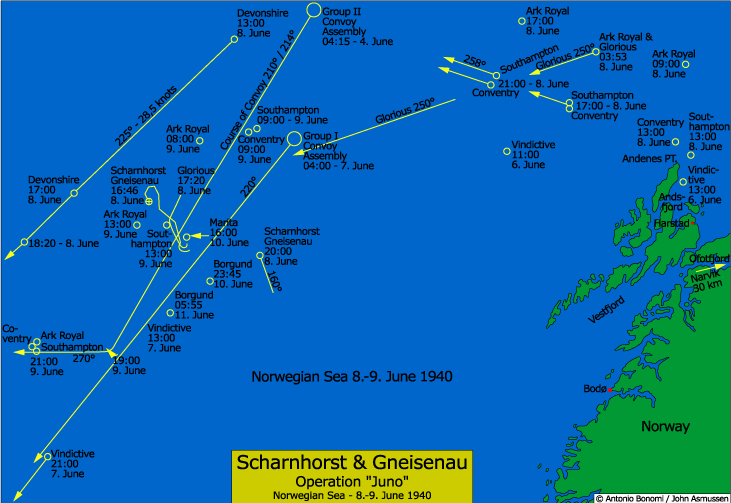
But - the paradox of maritime hegemony - all these ships had their tasks, they were not where they should be, or they could not abandon the escorted convoy, or they could not risk passengers on board ... ultimately, having sunk Glories and the destroyers of the escort, the Germans gone This luck was their random - they were not looking for a warship that could be drowned, relying on the fire superiority of a pair of battleships. But what prevented them from seeking such opportunities, do they understand the nature of war at sea a little bit better? Nothing. Find a convoy, destroy escort in battle, the remaining forces to catch up and melt as many transports as possible.
By a certain point, the British might well be faced with some shortage of warships. And this would make the German communications war, waged by submarines and auxiliary cruisers, much more successful. The British simply could not allocate as many forces to guarding convoys as they allocated in reality - they would have to hunt for raiders destroying their combat fleet faster than they could restore it. And if German submarines had already joined the hunt for warships somewhere in the Mediterranean ...
Of course, all of the above actually happened on the outskirts of Europe - off the coast of Norway. But after all, the Germans had quite successful military campaigns far into the ocean.
Episode 2. Operation Berlin
22 January 1941, the Scharnhorst and Gneisenau set off on a long voyage into the Atlantic with the task of sinking British convoys. In the course of this operation, a pair of ships caught the eyes of the English more than once, it was reported by attacked ships, and in general, the British had an idea about what was happening in the ocean. But, as has already been said, driving a surface ship into the ocean is not a trivial task, and this is to say the least. 22 March of the same year, a pair of battleships moored in Brest, and the British merchant fleet decreased by the 22 ship. The operation was commanded by Gunther Lutjens, who replaced Marshall's “all Kriegsmarine raider” because of the conflict with Röder. The replacement was not good and had fatal consequences. Master of the cruising war Marshal, the only admiral who sank an aircraft carrier in an artillery battle (at that time) and a capricious, capable of independent decisions commander, would still be more appropriate in place of Lyutyens.
What is characteristic of Operation Berlin? First, a pair of German battleships “combed through” British shipping with absolute impunity, although three times it ran into strong escorts. 9 February ships were dangerously close to the battleship Ramilies in the North Atlantic, 16 February south-west, they very little diverged from the battleship Rodney, 7 March to the east of the African coast likewise left the battleship Malaya and 20 in March spotted them aircraft from the aircraft carrier "Arc Royal". But the British didn’t manage to attack the German unit, although since the time of its launch into the sea, large forces had been sent to capture him. But the sea is big.
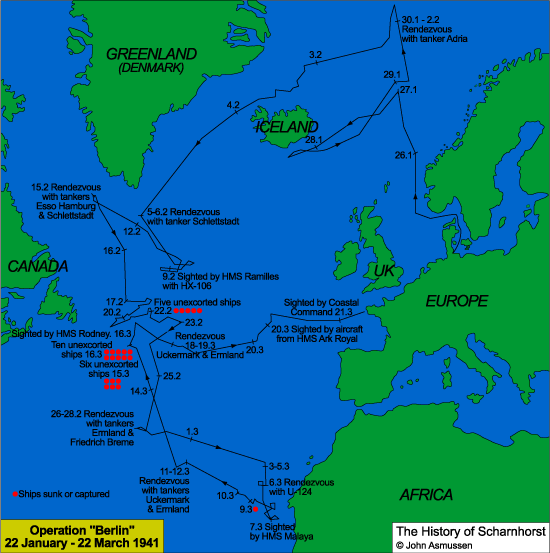
Question: could the Scharnhorst and Gneisenau be able to destroy not the merchant ships, but the British warships? Consider the situation with the release of the German connection to the convoy HX-106.
On 8 December, only one ship was part of the convoy escort - the Ramilies battleship built in 1915.
The remaining half-dead destroyers of the First World War and the Flower Corvettes became part of the guard a few days later, after the alarm raised because of the Scharnhorst and Gneisenau. In theory, the Germans might try to fight the British Briton and drown him. Of course, it was a risk: Ramilies X-inch guns could shoot at the same range as the German 15-millimeter guns, and the 280-inch projectile mass was much more. But on the other hand, the Germans had 15 trunks against 18 from Ramilias and excellence in maximum speed at about 8 nodes. This together allowed the British to impose any battle scenario.
Moreover, if the Germans had a little better debugging of the interaction between the surface and submarine fleets, the battleships could lure the English battleship out of order of the convoy, send the U-96 submarine to Ramilies, which already attacked the convoy after a couple of days, sinking a couple of transports, and then calmly kill all merchant ships from guns. This was all the more real, because in the same campaign the German ships did guide the submarines, just later. You could try to attack the battleship at night at the ultimate range of real fire, using the guidance on the radar. It was possible to fire a battleship, and then send a submarine on it. With the sinking of "Ramilies" in the Western Atlantic, the British had a very serious "hole" in the defense, which they would have to urgently close with something ... but what?
The damage to the Britons would be especially painful if the Scharnhorst and Gneisenau were to go through all these anti-submarine trawlers, corvettes, destroyers of the First World War and the old leader who were on the way to the convoy in those days. It sounds ridiculous, but just a year ago, Britain was forced to make a deal "destroyers base", giving strategic military facilities for fifty decaying destroyers of the First World War, as one of the officers who took them - "the worst ships ever seen." The British experienced simply a monstrous shortage of escort ships, and those ships that they would use would have been shot by any of the German ships "dry." It would have been a much more painful blow than the sinking of merchant ships.
Lutiens blindly followed Hitler's order not to engage in battles with British surface ships. Operation Berlin did not entail a reduction in the combat strength of the Royal Navy of Great Britain. However, during this operation, the Germans showed that, despite the British dominance at sea, despite their numerical superiority in warships of all classes, despite the presence of aircraft carriers and deck aviation, a small connection of raiders can break through into the ocean, and conduct intensive military operations there, and return back. Which, in fact, happened, only the goals were chosen not by those.
Episode 3. Campaign "Bismarck" and "Prince Eugen"
Much has been written about this campaign, but for some reason no sane conclusions have been made. What can we learn from Bismarck’s first and last combat campaign? First, the raider can break into the ocean even if it is waiting for large forces. The Bismarck waited and it broke through.
Secondly, it is worth thinking about Lyutens’s request to give him Scharnhorst, Gneisenau, and ideally Tirpitz, when he can go to sea, and postpone the operation until Tirpitz and repaired Gneisenau . Roder denied everything, and was wrong. During the "Berlin" Lutyens managed to perform a combat mission with two ships. It is self-evident that the British, for whom possession of the sea is a fixed idea, will take various measures to prevent the recurrence of such an incident. This means that in order to "attack in the same direction against an enemy already warned," it was necessary to bring larger forces into battle. Were the English ready for this? Not. So what? This means that the same forces that were actually thrown at him would be thrown at the interception of the German compound.
That is, even if, together with Bismarck and Prince Eugen in the Danish Strait, there also appeared, for example, Scharnhorst (even if it is only one), then all the same, the same “ Hood "and" Prince of Wales. " Only Germans would have nine more 280-mm trunks. And if the sinking of "Hud" is more likely a statistical fluctuation, then the failure of the "Prince of Wales" and its withdrawal from combat is a regularity in those circumstances. A “Scharnhorst” in the group would have made it natural, and not accidental, that the failure or sinking of Hud and much more severe damage on the battleship.
And thirdly, if the Germans would not pursue the ephemeral goal of fighting convoys, but would “raid” the surface fleet of the British, after the battle in the Danish Strait, Lutjens would have done what he had there and then asked the commander of Bismarck, captain Ernst Lindemann - chase the "Prince of Wales" and finish him. That is how the Bismarck’s first combat campaign would have ended, and after the battle with the battleship the compound had only one road - home to the nearest port for repair. And the task to finish off the "Prince of Wales" in those particular conditions does not look at all unreal.
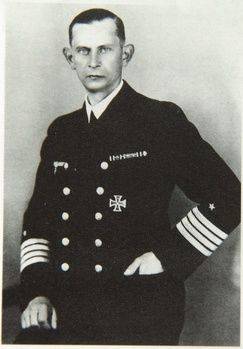
In fact, if the Germans acted rationally, then up to a certain point they would “bring” a battleship from each campaign. And each time, reducing the military power of the Royal Navy would reduce the ability of the British to defend their convoys. The logic would be very simple - no battleship or cruiser in the convoy? Any German auxiliary cruiser can rewind the remaining escort junk and then send vehicles to the bottom in batches. Few auxiliary cruisers? But a lot of submarines, and in contrast to what was really in history, they will attack convoys or solo ships without an escort. Always or much more often than in reality. The infliction of continuous losses to the Royal Navy would facilitate the activities of the Italian Navy, and this, in turn, could affect the outcome of the battles in Africa, the same Rommel could have won at El Alamein if he had the fuel for maneuver. Everything was interconnected in the war at sea, and the Germans did not have to make transportation their main goal, but the warships that made Britain the "Lady of the Seas." Sooner or later they would have overstrained anyway, only the “wave” launched by the sinking battleships would change the course of the war and not in favor of the allies.
And when there would be a "break"? “Bismarck” died due to accumulated mistakes - Roder, who did not give Lutjens the necessary amplification, which he requested, and Lutjens himself, who first had to listen to the commander of his flagship, and then maintain discipline when using radio communications and not invent anything for the enemy. The death of this ship was not predetermined, at least there and then.
But it turned out as it happened, and as a result, in naval affairs, he understood absolutely nothing Hitler himself and strangled his surface fleet, depriving himself of yet another opportunity to delay or change the inevitable finale of small Germany’s war against almost the entire world.
The battle score at the end of 1941, however, was in favor of the Germans - they sank an aircraft carrier, a battle cruiser, two destroyers and a minesweeper in their surface raids. You can also add here a submerged cruiser (essentially a merchant ship with weapons) light cruiser "Sydney". The price of all this is one battleship and that auxiliary cruiser.
And, of course, submarines - they remained outside of our consideration, because the then submarines could not chase surface targets or jerk out of the raid through the floor of the ocean. It was difficult to use them precisely as an instrument of raiding aimed at the destruction of the enemy’s surface fleet. But to give a categorical order in the presence of a military goal to beat her, and not to wait for a safe opportunity to attack the transport, it was possible. Germany’s submarines were outnumbered by surface fleets and could sink and sink large surface ships of the British. By the end of 1941, their track record included two battleships, two aircraft carriers, one escort aircraft carrier, two light cruisers and five destroyers. The losses, of course, were incomparable with those in surface ships - by the end of 1941, the total number of submarines submerged reached German 68 units. And these losses, in contrast to Bismarck, were completely predetermined.
We can only guess what the Germans could achieve, they choose the right target from the very beginning. In the end, in the Pacific, American submarines sank more warships than all the other types of naval forces combined - 55% of all casualties, if you count by pennants. Nothing prevented the Germans to do the same.
Nothing prevented them from then coming to the naval battle groups from ships of different classes - battleships, cruisers and destroyers who would perform their specific tasks as part of the group, nothing would prevent later to interact with the submarine fleet, to include in the raid forces attached parts of the Luftwaffe their Fw200 ... that strap, which the KVMS of Great Britain could eventually drive the Kriegsmarine surface forces into the bases (in reality, Hitler did it) could be very, very high.
Lessons for modernity
Germany, with its powerful ground forces, was significantly inferior to its enemies in total sea power. In addition, its ports and bases were mostly isolated from the world ocean, where the main communications of the allies were held. Today, Russia is in the same position. Our fleet is small, it does not have a coherent strategy of application, and it will not endure a battle with the fleets of potential enemies. And the economy will not allow us to build a fleet comparable to the US, and not only in it, even if we had the money, the demographic “wave” on the threshold of which our society stands, simply will not allow us to form as many crews and coastal parts. We need a new paradigm, and it is very desirable that it should not be reduced to nuclear suicide as the only scenario, although no one is going to be dismissed.
And in this sense, the idea of raids aimed at weakening enemy fleets deserves careful study. In the end, what, if not, were the massive air strikes planned by the US and NATO naval forces planned in Soviet times? Raids as they are, and their goal was just warships. After all, what has fundamentally changed since the Second World War? Satellite intelligence? They know how to deceive her, and missiles that can knock down a satellite on American ships already exist, and may appear on the rest in the foreseeable future. And a shipborne radar capable of providing DD for a target in near-earth orbit is no longer a reality, but rather a story, albeit the newest one. Over-the-radar? The mass distribution of sea-based cruise missiles will bring the game out of the game during the first hours of the conflict. All-weather long-range strike aircraft? But the organization of accurate air strikes on surface targets at a distance of a thousand kilometers or more is so difficult that most countries in the world will not even take it. The sea is big. Nuclear submarines? They can chase the high-speed surface target only at the cost of complete loss of stealth. We can easily face the fact that very little has changed since the Second World War, and that it is still incredibly difficult to “catch” a surface ship in the ocean, even when you almost know where it is.
And that the shipboard strike group may well fight off aviation as well, as it was more than once in the past. And then the old experience suddenly turns out to be very valuable and useful, provided that it is correctly understood.
How can raiders be deployed in the ocean? And just as the USSR did in advance of bringing the forces of the fleet to combat service. Only there they were in a position from which it was possible to lead the enemy in tracking weapons and, if necessary, deliver an immediate blow to him, and the deployment regions were the same almost always. In our case, tied to the Mediterranean, or something else is not necessary.
What is the key to success today? And the same as in the past - the forces of the modern naval hegemon are also scattered throughout the planet in small groups - AUG "peacetime" with a couple of destroyers in the escort, amphibious combat groups formed "around" UDC with airplanes, they are all basically very far from each other, significantly farther than the range of the daily transition at maximum speed.
And all this, of course, does not eliminate the need to sink military tankers. But they must be followed by a strike on an aircraft carrier, whose fighters remained for a couple of days without kerosene.
What should be the raider ship? Pretty powerful. It should have a lot of missiles, both for strikes on the coast (on airfields for neutralizing aircraft), and for strikes on ships and submarines. He must have a powerful defense. It must significantly exceed the competitors in the range of the course and maximum speed - just for separation from the superior naval forces of the enemy.
And of course, such actions should be worked out, both on the map and at sea, with a real adversary. Learn from him and lucidly show what awaits him if their politicians bring the matter to a real explosion. Continuously improve and experiment, to always put the enemy in front of a fait accompli.
So that later, in the future, other people's descendants would not argue idly about the opportunities we have missed.
- Alexander Timokhin
- scharnhorst-class.dk, Wikipedia commons
Information